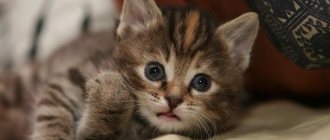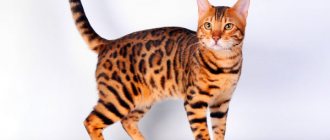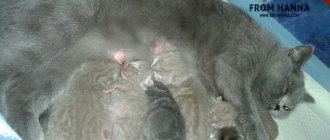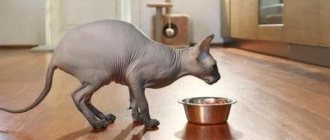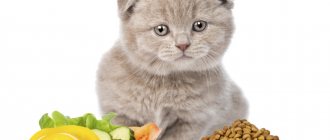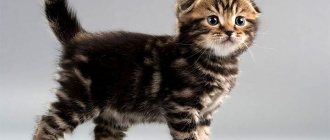Save the article:
The health and mood of the cat depends on how and what the owner feeds his beloved pet. Feeding a kitten at 2 months
it is necessary according to the recommendations of specialists: the baby is already feeding on his own, many are left without a mother, and the further development of the cat depends on the owner.
The diet of two-month-old kittens differs from the diet of a 1-month-old kitten. The body continues its development and growth, mother's milk and formula are no longer required. If you don’t choose the right balanced diet, your baby’s immunity will begin to weaken. Therefore, it is important to study all the nuances of feeding a two-month-old kitten and not make unnecessary and dangerous mistakes.
Choosing a diet for a two-month-old kitten
If the diet is chosen correctly, then soon the clumsy baby will turn into a playful, strong and powerful cat or a beautiful healthy cat. The main signal that the food is not suitable for the kitten is an intestinal disorder and the animal’s categorical refusal of the offered treat.
There are three options for suitable nutrition for young cats, and the choice should be made on one of them:
- ready-made feed:
- natural food;
- mixed nutrition.
Probably, the kitten himself will make the choice for the owner. But sometimes it’s worth calculating your financial capabilities and choosing the best option. The breed of the cat, its health and preferences also play a role.
Procedures for a 2 month old cat
The sooner you start taking action, the better. After the first days of adaptation, start with these basic procedures:
- Physical stimulation : It is important to encourage your kitten to be physically active. This will promote muscle development and help avoid excess weight. The playtime you share with your two-month-old cat is part of the physical stimulation, but try to offer him places and toys that will allow him to entertain himself.
- Mental stimulation : Just as important as the previous one, you get this by enriching your space with cat structures, tunnels, or a few simple cardboard boxes. Intelligence toys are also very useful.
- Brushing and hygiene : Although your two-month-old cat will take care of her own grooming, it doesn't hurt to give her a hand. In addition, if he gets used to your caresses and brushes his hair, your bond will strengthen.
- Play together for fun : Although you may not believe it, cats are very social and love playing with people. We recommend playing with it a little every day.
- Love is the main thing . In addition to the above steps, your kitten will need your love and affection. You will be seen as if you are offering it, interact with you. He will even want to cuddle up to you, lick you, or bite you... all signs of affection.
As you can see, you need to make some changes and put certain routines into practice with a 2 month old cat. However, all the effort is worth it. Having a cat at home is beneficial for the whole family.
Ready-made feed
global $ads_google;
//data-ad-slot=”2475549904″ $ads_google = empty($ads_google) ? false : true; ?> if ($ads_google == false) {?> $ads_google = true; ?> } ?> Ready-made food can be dry or wet. For a two-month-old baby, it is contraindicated to mix them with each other, since they are digested at different time intervals, and the baby’s stomach is not yet ready for such a feat.
If, after feeding one type of food, you need to switch to another, then accustoming to the new food occurs gradually over 10 days: small portions are introduced and the body’s reaction is monitored.
Some manage to combine two types of cat food, 75% of the nutrition is the dry variety, the rest is wet.
A good food manufacturer offers products taking into account all cat characteristics. For this purpose, whole lines of food are produced: from 2 months to a year, from a month to four. The composition of such nutrition is selected with the optimal content of calcium, protein, vitamins and minerals.
Advantages and disadvantages
The main advantage of ready-made food is that it is already a balanced source of nutrition, where the vitamin and mineral complex is fully adapted to the nutrition of a two-month-old animal.
Another plus is the dry food itself: the baby actively works with his jaws in an attempt to chew the tasty granule. The owner does not need to select the composition of the food himself or calculate the required content of nutrients - in general, this is a great time saver.
It is convenient to take ready-made food on a trip without worrying about what the baby will eat if the journey is long.
Disadvantages of nutrition:
- Economy class food contains a large amount of unnecessary mineral salts. They accumulate in the body and provoke urolithiasis;
- The granules contain flavorings and preservatives that cause addiction. You can switch to natural food only by forcing your pet to starve.
It is better to ask your veterinarian whether it is worth giving your baby such food.
What veterinarians say
If it is difficult and unclear what to feed a kitten at 2 months
, seek advice from a veterinarian.
- Buy food only in veterinary pharmacies and pet stores.
- It is best if it is marked “premium” or “super premium”.
- Holistics are considered the best foods; their benefits are maximum, as they preserve the freshness of almost unprocessed meat.
- Purchase products indicating the appropriate age of the animal.
- Portions are given according to the dosage indicated on the pack.
If you follow the advice, you will not have any problems with nutrition.
What should you not feed?
What you should not feed kittens at 2 months of age (and at other ages too):
- fatty meat - pork, lard, lard, goose - the sensitive little stomach will develop indigestion, and the liver will not cope;
- bones (the kitten can choke on them or damage the esophagus);
- whole milk (cats lack enzymes to digest milk);
- protein from a raw egg (the enzyme it contains has a destructive effect on biotin in the body);
- salted, smoked, peppered and canned foods for people;
- skin from chicken meat - it is not digested in the stomach;
- some vegetables (tomatoes, onions, garlic, eggplants) and fruits (avocado);
- chocolate (very toxic to cats and can cause premature death);
- vitamins and medicines for people with some exceptions.
Foods that should be kept to a minimum:
- peas and beans (cause bloating);
- freshwater fish (leads to infection with helminths, it is better to completely remove it from the diet).
Natural food for kittens of two months
The owner of a growing cat sooner or later asks whether it is possible to feed the baby homemade food. The question has a twofold answer: yes and no.
Not if home-cooked food means food prepared for the whole family. And yes, if it is a separately prepared food, taking into account the age characteristics of the pet, its health and other characteristics. Such food will be devoid of harmful additives and unnecessary ingredients.
Advantages and disadvantages
global $ads_google;
//data-ad-slot=”2475549904″ $ads_google = empty($ads_google) ? false : true; ?> if ($ads_google == false) {?> $ads_google = true; ?> } ?> And natural food has its pros and cons.
Advantages:
- Since the owner himself selects the diet, it is no secret to him what the food will consist of. A caring owner can be calm about both the quality and composition of the food;
- food becomes varied;
- there is no food addiction, and products are interchangeable without any stress for the kitten.
Flaws:
- you need to remember which products are on the list of prohibited foods and do not offer them to your young cat;
- there is a possibility of not receiving the required amount of vitamins and minerals, so they will need to be purchased separately. Adding them to a dish is difficult when calculating the correct dosage.
If the owner decides on natural nutrition, then he must study all the accompanying recommendations.
Feeding recommendations
The second month of a kitten’s life is active, the baby needs a lot of energy and strength. The daily diet includes meat products: beef, turkey, chicken. Cooked meat is given in ready-ground form and added to the broth. Raw meat is still prohibited!
In order for the skeletal system and teeth to develop well, the kitten is fed kefir, fermented baked milk, yogurt without additives, and low-fat cottage cheese is introduced by the end of the second month.
The diet includes milk porridges made from cereals and cereals, or porridges with a decoction of vegetables or meat, vegetables and low-fat boiled sea fish without bones.
There are prohibited foods: pork, lard, pork fat, goose, bones, cow's milk, raw egg whites, pickles, chocolate. Freshwater fish and legumes should not be offered.
Natural products
Many owners of newly acquired furry babies are often surprised to hear that the kitten is strictly forbidden to give food from the common table. The fact is that human food contains a lot of salt and spices, flavor enhancers and other impurities that can cause poisoning or intoxication in a growing animal. If you choose a natural diet, you should be prepared for the fact that your pet will have to cook every day.
The menu should be varied and consist only of high-quality and fresh products. The diet includes:
- Lean meats - beef and chicken, veal and turkey, rabbit. The meat is served boiled. It should first be frozen for at least 3 days. High-quality heat treatment will protect against helminth infection. At 2 months, the baby can be given minced meat or finely chopped meat. Do not serve it in large pieces, as the kitten may choke.
- Fish . This product is very useful and necessary for kittens, but you should not overuse it. Fish is given no more than 1-2 times a week. Only lean varieties of sea fish, namely fillet, are suitable for kittens. The fillet must be thoroughly cleaned of bones, pre-frozen, and before serving, cut into small pieces and defrosted to room temperature. Can also be served boiled.
- Fermented milk products should be present in the animal’s diet every day, as they are a source of calcium necessary for an actively growing body. Calcined cottage cheese and kefir, sour cream and fermented baked milk are suitable. Fermented milk products must have a minimum or medium fat content and not contain any additives.
- Vegetables are a must in a kitten’s diet. Serve raw or boiled, chopped through a fine grater. Recommended: carrots, cabbage, zucchini and pumpkin. Your pet is unlikely to want to eat vegetables in their pure form, so the best option would be to add them little by little to the minced meat. You can use vegetables to make lean broths that your kitten will really like.
- Sprouted herbs - wheat or oats. Not only are they a source of large amounts of vitamins and minerals necessary for the full development of a kitten. Sprouted crops help in the functioning of the digestive tract, cleanse the intestines, preventing the occurrence of flatulence.
- Egg yolk . Serve raw (as an addition to minced meat) or boiled. Despite the benefits for the body, yolk should not be constantly present in the diet. It can be given no more than once a week.
- Cereals : buckwheat, oats and rice. Boil in water or milk diluted with water in equal proportions. Adding salt or sugar to porridge is strictly prohibited. Make porridge semi-liquid. Boiled cereals are not a separate dish, so they should be diluted with minced meat or vegetables.
Oil in the diet.
To improve the digestive system, it is recommended to give the kitten vegetable oil - sunflower or olive.
The oil is used as a dressing for minced meat, cereals or vegetables. Its amount should not exceed ½ tsp. for the whole week.
What to feed is prohibited
When creating a natural diet, it is important to take into account that there are a number of prohibited foods that should never be given to a kitten:
- Fish and meat bones - a kitten can choke, and the sharp edges can injure its esophagus and oral cavity, which is fraught with the development of inflammatory processes. When preparing fish, you must carefully remove all the bones.
- Bean products cause bloating and flatulence.
- Chicken skin is a very fatty product for kittens, which is very poorly absorbed by the delicate digestive tract.
- Cow's milk, whole - the baby's gastrointestinal tract does not absorb this product at all, which can cause stomach upset.
- Egg white – interferes with the absorption of vitamin B, may contain salmonella and E. coli.
- Fatty fish and meats cause indigestion.
- Salt, spices, sausages, smoked meats and marinades are unnatural foods for kittens. Such products often contain food additives that cause severe poisoning and intoxication. The presence of salt in the diet can provoke the development of urolithiasis in the kitten in the future.
- Sweets and confectionery products increase the concentration of sugar in the blood, which is fraught with the risk of developing diabetes.
- By-products, kidneys and liver are allowed, but in minimal quantities and rarely. Their frequent use can lead to intoxication.
- Raw river fish – can become a source of helminth infection.
Feeding according to breed. When preparing a natural diet for a kitten, it is recommended to consult a veterinarian, since each breed has its own characteristics. For example, it is not recommended to give Scottish Fold kittens a lot of fermented milk products. A large amount of calcium can cause their ears to straighten and rise (read the article on what to feed a Scottish fold kitten).
Mixed nutrition
There is an opinion that simultaneous feeding of natural food and ready-made food is harmful to kittens and can even give rise to the development of diseases of the digestive organs. The opposite opinion states that a two-month-old pet will get just everything it needs from a mixed diet. The dosage of nutrition is clarified by a veterinarian: he will take into account the animal’s health status, weight, breed and suggest a feeding plan.
The selected diet will remain this way throughout the month. The main difficulty will be to prevent hypervitaminosis. Therefore, you must strictly adhere to the calculated dosage.
Veterinarian advice
For cats living in apartments, their daily routine is very important. The sooner a kitten gets used to receiving food at a certain time, the faster its digestive system will adapt to an adult diet. This is due to the fact that digestive enzymes will reach their maximum concentration strictly at the hour of feeding, which will have a positive effect on the absorption of food.
The place in which the pet is fed is chosen to be quiet and calm, where the kitten will not be in the aisle and will not be disturbed. Without this, against the backdrop of constant stress while eating, your pet may develop digestive problems, which will negatively affect its development and growth.
When there are several kittens in the house, their food bowls are placed in different places. This avoids competition for food that is unacceptable. If the kittens compete, then the weaker pets will remain hungry, and the stronger ones will begin to overeat. As a result, everyone's health will be harmed.
Nibelung cat breed, character and description
The kitten should only be given food at room temperature. Do not give hot food. It is unacceptable to expect that the baby will wait until it cools down. In most cases, the kitten will get burned and become afraid of the bowl, which will significantly complicate the feeding process. If the burn is severe, then treatment will also be required.
How to feed a kitten at two months
There are simple rules for feeding a two-month-old pet:
- The daily portion of natural food is not given immediately, the baby does not yet control his appetite. Dry food can be poured in immediately;
- all food should be warm. If the food was in the refrigerator, it is heated;
- cooked food should not be stored in the refrigerator for longer than 24 hours;
- wet prepared food is stored open for no more than two days;
- if the food is natural, vitamins for cats are added to it;
- There is water in a separate bowl. The bowl should be freely accessible, and the water should always be clean and fresh.
It will not be difficult for a responsible person to follow all the nutritional rules for a kitten, and the pet will grow up strong and healthy.
How often to feed a 2 month old kitten
global $ads_google;
//data-ad-slot=”2475549904″ $ads_google = empty($ads_google) ? false : true; ?> if ($ads_google == false) {?> $ads_google = true; ?> } ?> To avoid problems with the baby’s health, you need to know how many times to feed and what the portions should be.
The kitten should not overeat or remain hungry - both cases promise problems with the digestive system.
A baby at 8-10 weeks is fed frequently: the daily diet is calculated at 5-6 small portions. If we take into account the weight of the kitten, then we proceed from an approximate recommendation of 150 g per 1 kg of body weight.
Tables of norms by age
In order to make it more convenient to understand how many times a day a small kitten should be fed, we have compiled both the amount of food and the number of feedings per day into a single table.
| Kitten age | Amount of food per day in grams (it is divided into equal-sized portions for as many feedings as the pet’s age requires) | Number of feedings per day |
| 4-8 weeks | 120 | 7 |
| 8-112 weeks | 160-180 | 6 |
| 12-20 weeks | 180-240, with a minimum meat volume of 40 g | 5 |
| 5-9 months | 180-200 | 4 |
| 9-12 months | 180-200 | 3 with gradual transition to 2 by age 1 year |
For each kitten, the norms may vary slightly depending on its individual characteristics. However, it is necessary to use them as a guide, since otherwise the pet may not receive enough nutrition or, conversely, be overfed, and obesity in cats poses a great danger, leading to the rapid development of pathologies of internal organs.
Features of feeding kittens at 2 months in different breeds
The diet depends on the breed: some cats need more protein, while smaller animals cannot cope with large portions. Different cats have different nutritional recommendations. If a kitten is adopted from a breeder, then you can get full advice on many issues on the spot, including diet. If a kitten is just taken from the breeder, then be sure to first continue to feed it the same food to which it is accustomed. A change in diet, if desired, occurs only after 2 weeks.
Feeding Scottish kittens
At 2 months, the little Scotsman is weaned from the cat's breast. The fold-eared baby is weaned gradually, without causing stress to either the kitten or its digestive system. The Scottish cat's diet consists of 6 servings with a total volume of 160-180 g per day. It is better to mix meat with vegetables and cereals in a 3:1 ratio. At one meal they give a meat and vegetable dish, at another - meat porridge.
Feeding a Maine Coon kitten
A Maine Coon kitten at 2 months can be fed natural food: offal, yolk, fermented milk products, and cereals are used. Vegetables are given up to 16 times a month. It is useful to feed the future cat with sprouted grass and shrimp. Maine Coons should not be offered salty foods, especially those with spices and pork.
The total amount of food per day is 210-240 g.
Feeding a Sphynx kitten
At 2 months, there are also some recommendations for a hairless Sphynx kitten. They benefit from rice broth, buckwheat and oatmeal. Boiled carrots, beets and cabbage are also added. They don't give milk to bald people! Instead, they offer kefir and 0-5% cottage cheese.
All products must be fresh, and dry food must not be expired by a day. Saltiness and smoked foods are contraindicated for the Sphinx.
Feeding a Bengal kitten
At 2 months, a Bengal kitten has its own food requirements: this breed loves meat very much. Boiled meat is cut into tiny pieces, and raw frozen meat is simply scraped with a knife, cutting off the top layer. Then the shavings are warmed to room temperature and offered to the pussy. But it’s better to stick to boiled meat. Bengal will appreciate porridge made with meat broth and the consistency of sour cream. Raw vegetables are not offered.
The baby is fed 6 times a day.
Feeding a British kitten
A young Briton eats 7 times a day at 2 months old. You can treat your baby to milk for kittens (25% of the diet), low-fat cream and cottage cheese (not at the same time as milk), milk porridge and canned food for kittens.
The British breed will also not refuse boiled meat, cut into small pieces.
Diet selection
Feeding a kitten at 2 months is not difficult to organize. A matured body and a mature digestive system make it possible to expand the pet’s diet. You need to approach the preparation of the daily menu responsibly, having first decided on the type of feeding:
- Natural food : vegetables and cereals, meat. Meat (boiled or fresh) is a natural food for animals. Therefore, preference is given to him. However, this diet requires some effort on the part of the owner. Since it is strictly forbidden to give food to a kitten from a common table, you will have to prepare new dishes every day. And this causes difficulties for owners who are often away from home for long periods of time. Another disadvantage of natural nutrition is the need to give vitamin complexes, since it is impossible to obtain nutrients and beneficial substances from foods in sufficient quantities.
- Industrial diets are tasty and healthy for the kitten and, moreover, very convenient for the owner. You can be away from home for a long time, the food will not spoil or lose its quality after being in the bowl for several days. There is only one drawback to this diet - food for a 2-month-old kitten needs to be chosen of high quality, which is not cheap.
- Mixed diet – some owners feed kittens with natural products most of the time, and, if necessary, provide industrial food. This feeding diet is allowed, although not particularly approved by veterinarians. Mixing different types of products in one bowl is strictly prohibited. It is recommended to separate them, giving them at different meals.
You should immediately decide what diet the kitten will be on and stick to it constantly. Transferring from “natural” to “drying”, and vice versa, is extremely undesirable for the health of the kitten.
Caring for kittens at 2 months
Touching meowing babies at two months of age remain fragile creatures. They are ready to be attacked by infections and parasites. The owner’s task is to protect the fluffies from danger. Timely vaccinations and timely deworming will help fight infections.
The veterinarian should be a friend: a source of necessary advice and regular examination.
The baby's appearance needs care: this is the time to accustom him to a comb, the procedure of washing his eyes and cleaning his ears. A healthy pet sparkles with beautiful fur and is in a good playful mood.
Features of care
Small pets at 2 months are still very fragile creatures and are susceptible to various infections and parasites. It is necessary to especially carefully monitor their health, give them vaccinations at the right time, and carry out deworming. If you have any concerns or concerns regarding nutrition or health, please contact your veterinarian immediately. Observe the appearance and behavior of your pet: it should be well-fed with shiny fur and active in games. Particular attention should be paid to the constant availability of fresh water for the kitten, especially when feeding with industrial food.


